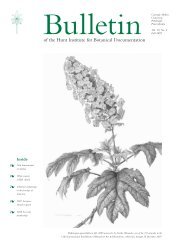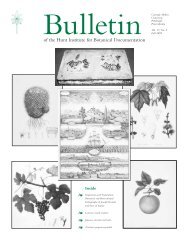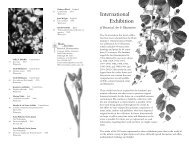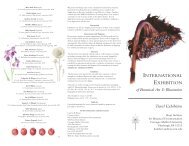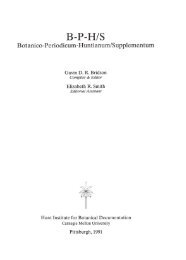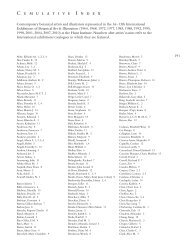Bulletin - Hunt Institute for Botanical Documentation - Carnegie ...
Bulletin - Hunt Institute for Botanical Documentation - Carnegie ...
Bulletin - Hunt Institute for Botanical Documentation - Carnegie ...
Create successful ePaper yourself
Turn your PDF publications into a flip-book with our unique Google optimized e-Paper software.
Delectus <strong>Hunt</strong>iana 26<br />
Paintings by Pancrace Bessa <strong>for</strong> Herbier Genéral<br />
Pancrace Bessa (1772–1835) was a gifted pupil of both Gerard<br />
van Spaendonck (1746–1822) and Pierre-Joseph Redouté<br />
(1759–1840) at the Jardin des Plantes (<strong>for</strong>merly the Jardin<br />
du Roi). Following the pattern set by his masters, Bessa<br />
instructed a number of the nobility and was appointed<br />
painter of flowers at the Jardin. He made nearly all the small<br />
drawings <strong>for</strong> the 600 plates of Mordant de Launay’s Herbier<br />
Genéral de l’Amateur (Paris, 1810–1827), the most important<br />
French flower periodical of its day.<br />
The history of these paintings is recounted by Carol H.<br />
Woodward (“Bessa’s paintings,” Flower Grower, January<br />
1947); Isis (“Brazilian <strong>Botanical</strong> Paintings of the Early<br />
Nineteenth Century,” May 1947); Claus Nissen (Die Botanische<br />
Buchillustration, entry 2323, pp. 221–222, 1951); and Wilfrid<br />
Blunt and William T. Stearn (The Art of <strong>Botanical</strong> Illustration,<br />
1994, p. 209). Woodward wrote “Of the paintings made<br />
by Bessa <strong>for</strong> the first eight volumes [of Herbier Genéral de<br />
l’Amateur], at least 500 remain today in one collection.”<br />
Charles X of France gave the Bessa paintings and text to the<br />
Duchess of Berry in 1826. The Duchess later gave them to<br />
her sister, Teresa Cristina, who went on to marry Dom Pedro<br />
II, the Emperor of Brazil. Be<strong>for</strong>e Dom Pedro fled in exile<br />
from Brazil in 1889, he presented the items as a personal gift<br />
to Barbosa Rodrigues, the newly appointed director of the<br />
<strong>Botanical</strong> Garden in Rio de Janeiro. After Barbosa Rodrigues<br />
died in 1909, his son-in-law, Joaquim Augusto Campos-Porto<br />
served as vice-director and acting director of the institution.<br />
Paulo Campos-Porto, Joaquim’s son, worked at the garden as<br />
a boy and became director in 1932. In 1922 Paulo acquired<br />
the Bessa paintings and text at the auction of the estate of<br />
the widow of Barbosa Rodrigues. After their first public<br />
exhibition in Rio de Janeiro in June 1946, Paulo Campos-<br />
Porto’s daughter Mrs. Flora de Campos-Porto Castaño<br />
Ferreira took the collection to the United States where at least<br />
two exhibitions are documented — one at the 113th meeting<br />
of the American Association <strong>for</strong> the Advancement of Science<br />
in Boston in December 1946 (see Nissen and Isis) and another<br />
of 100 paintings at the New York <strong>Botanical</strong> Garden (see<br />
Woodward). Woodward’s article concludes, “In<strong>for</strong>mation<br />
about the possibility of exhibits elsewhere in the country may<br />
be obtained by writing to Mr. Rodrigo Claudio de Campos-<br />
Goulart, in care of the Brazilian Consulate, 10 Rockefeller<br />
Plaza, New York 20, N.Y.” Six paintings subsequently were<br />
purchased by Mrs. <strong>Hunt</strong> from Mrs. Ferreira in May 1949<br />
— Monarda didyma, Neomarica gracilis, Cypripedium calceolus,<br />
Gordonia altamaha, Dracontium sp. and Enkianthus quinqueflorus.<br />
Each work, 10 1/2 x 8 1/4 inches, is on vellum, includes a<br />
gold border, and is signed “P. Bessa” at bottom left.<br />
Other Bessa paintings are in the collections of the National<br />
Museum of Natural History Library, Paris; the Fitzwilliam<br />
Museum, Cambridge; the Royal Horticultural Society,<br />
London; Pierpont Morgan Library, New York; and the<br />
Holden Arboretum, Kirtland, Ohio (a manuscript version of<br />
the first 72 entries of Herbier Genéral accompanied by unsigned<br />
watercolors, probably by Bessa). For more in<strong>for</strong>mation<br />
about these artworks see Brent Elliott’s Treasures of The Royal<br />
Horticultural Society (Portland, Sagapress/Timber Press, 1994,<br />
p. 94), Stanley H. Johnston, Jr.’s Cleveland’s Treasures from<br />
the World of <strong>Botanical</strong> Literature (Wilmington, Orange Frazer<br />
Press, 1998, p. 90) and The Cleveland Herbal, <strong>Botanical</strong>, and<br />
Horticultural Collections (Kent, Kent State University Press,<br />
1992, pp. 929–930), David Scrase’s Flowers of Three Centuries:<br />
One Hundred Drawings & Watercolors from the Broughton Collection<br />
(Washington, D.C., International Exhibitions Foundation,<br />
1983, pp. 9–10), and the Pierpont Morgan Library’s Flowers<br />
in Books and Drawings, ca. 940–1840 (New York, Pierpont<br />
Morgan Library, 1980, entries 124–125).<br />
We can never account <strong>for</strong> the original collection of Bessa<br />
paintings from de Launay. Bits of in<strong>for</strong>mation about their<br />
auctions are cited by Woodward (Rio de Janeiro? about<br />
1922); Scrase (Beverly Hills, Cali<strong>for</strong>nia, 1946); The Pierpont<br />
Morgan Library (Gallery of Lewis S. Hart, Beverly Hills, 17<br />
November 1947); and Elliott (Christie’s, 1970).<br />
— James J. White<br />
Monarda didyma, watercolor by Pancrace Bessa, published in 1824.<br />
Long cultivated <strong>for</strong> oil of bergamot, potpourri and nectar <strong>for</strong> bees, this<br />
perennial herb, called Bee Balm or Oswego Tea, has a bright crimson corolla.<br />
Bull. <strong>Hunt</strong> Inst. Bot. Doc. 13(2), Fall 2001 5



